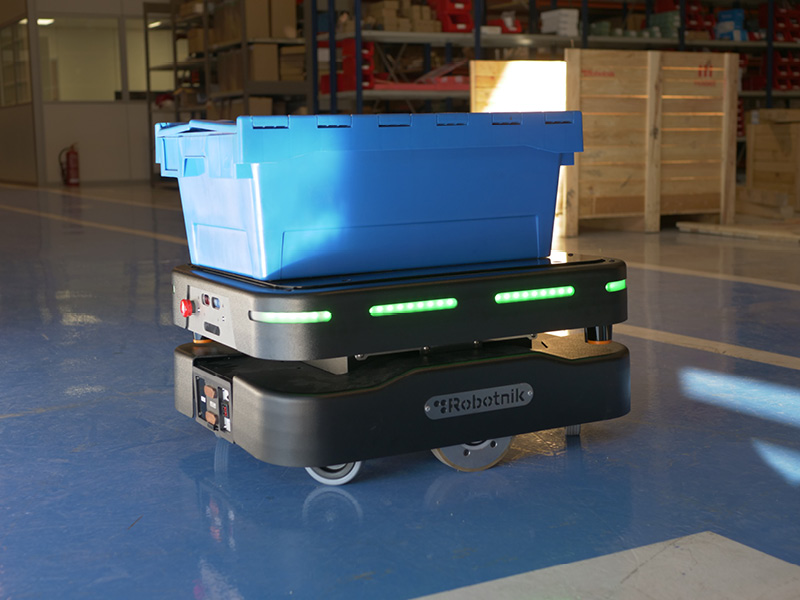In the last few years, logistics, warehouse management and order processing have undergone some significant changes. This rapid evolution has been driven by the need to meet increasingly faster delivery deadlines.
Thus, with the goal of streamlining the various processes involved in this area, Autonomous warehouse robots have been naturally introduced into warehouses and logistic environments.
Current applications of mobile robotics in warehouse transportation and automated inventory management are examples of how technology provides a significant boost in this sense.
This article explores the present and future of collaborative mobile robots in warehouses, factories, and similar logistic environments.

AUTONOMOUS TRANSPORTATION ROBOTS IN WAREHOUSES
Automating the transportation of loads, materials, goods, and orders within a warehouse remains currently one of the most demanded tasks. Mobile robots, like Robotnik’s RB-THERON and RB-VOGUI, developed for autonomous navigation, have different load capacities to efficiently move products from one place to another, reducing human involvement in repetitive tasks and improving efficiency.
Thanks to integrated navigation and localization systems, these autonomous transportation robots can identify the most suitable routes, avoid obstacles and optimize their movements. This reduces the need for human intervention in repetitive transportation tasks, thereby enhancing productivity and allowing employees to focus on strategic and higher-value tasks.
Here are some video examples of mobile robots such as RB-THERON or RB-VOGUI executing autonomous goods transportation in warehouses.
MOBILE ROBOTICS FOR AUTONOMOUS INVENTORY MANAGEMENT
Autonomous warehouse robots, equipped with advanced software and advanced sensors, are ready to move autonomously within storage spaces, scan barcodes or RFID tags, and constantly monitor real-time inventory information. This enables more precise and up-to-date stock management, avoiding common errors related to outdated or lost products. This has a direct impact on decision-making, as accurate data facilitates purchase planning and storage optimization.

THE FUTURE OF MOBILE ROBOTICS IN WAREHOUSE TRANSPORTATION
- Advances in Swarm Robotics
Advancements in swarm robotics will improve coordination and cooperation among fleets of robots, enabling even more efficient goods transportation and order delivery. - Integration of Artificial Intelligence and Machine Learning
In this article, the integration of AI and different machine learning techniques is developed in more detail, allowing mobile robots to learn from their experiences. This optimizes their performance in dynamic warehouse environments and enables smarter decision-making based on the environment. - Synergy Between Humans and Robots Collaborative robotics is the present.
However, the industry continues to work towards reaching new limits regarding safety and interaction between humans and robots, sharing the same workspace. - Adoption of 5G Technology
The integration of 5G technology provides robots with faster and more stable communication. As 5G connectivity advances and improves, the responsiveness and autonomy of mobile robots also increase. This aspect is crucial for warehouse robots since factory spaces sometimes have limited network access.
CONCLUDING
The adoption of mobile robotics in warehouse transportation is already bringing significant benefits to the industry, from improved efficiency and accuracy to increased worker safety. These robots are reshaping storage operations. Looking ahead, with advancements in artificial intelligence, swarm robotics, and human-robot collaboration, the future of mobile robotics in warehouse transportation presents even more useful perspectives for companies. As technology continues to evolve, warehouses will experience greater optimization, automation, and a general transformation in how products are transported and managed within their facilities.
If you need more info please contact with our team:

